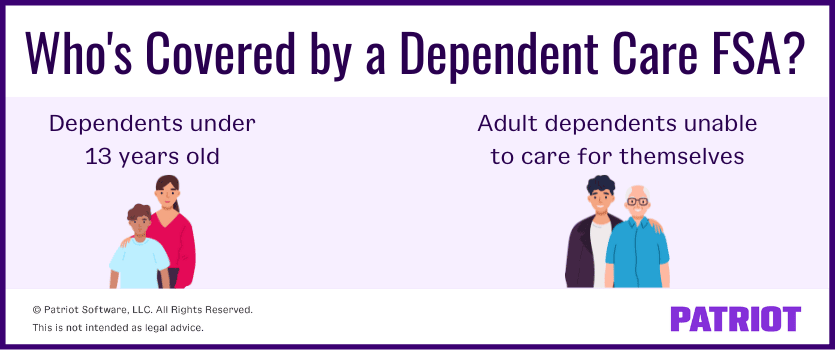Thinking about offering additional benefits to your employees? A dependent care FSA can help employees with the expense of caring for their dependents while also reducing their tax liability. Employers can also reap plenty of benefits from offering FSA dependent care, including increased employee engagement and reduced stress.
Read on to learn more about who’s covered by FSA dependent care and how it works.
FSA dependent care
A dependent care flexible spending account is a type of flexible spending account (FSA). An FSA is a pre-tax fund that employees can contribute to and use when needed. FSAs are typically included in section 125 plans (e.g., cafeteria plans).
Other types of flexible spending accounts include healthcare and adoption assistance FSAs. Whatever type of FSA you offer, they all have a few things in common. Flexible spending accounts are voluntary, pre-tax, and help cover qualifying expenses.

What does FSA dependent care cover?
A dependent care FSA helps with the costs of caring for dependents under the age of 13 or a spouse or relative who is unable to care for themselves and lives at home.
There are some specifics for each qualifying group to consider before deciding on a dependent care FSA for your employees.
Dependents under the age of 13
According to the Bureau of Labor Statistics, 32.8 million families in the U.S. had children under the age of 18 in 2021. And 89.1% of those families had at least one working parent. So, there’s a chance that a dependent care FSA could benefit a lot of your employees.
Here are some of the expenses that a dependent care FSA may cover for dependents under the age of 13:
- Before or after school programs
- Childcare
- Day camp
- Nursery school
- Preschool
Keep in mind that the average annual price of childcare in the U.S. is now $10,174. A dependent care FSA could go a long way in helping your employees cover the costs of caring for dependents under 13 years old.
Adult dependents
Close to one in five U.S. workers also work as caregivers for family members. The difficulty of caring for loved ones and juggling the extra costs may force employees to decide between continuing to work or being a caregiver. A dependent care FSA can keep employees with adult dependents in the workforce.
Adult dependents can include a spouse or other family members that are physically or mentally incapable of self-care.
Here are some of the expenses that a dependent care FSA may cover for qualifying adult dependents:
- Adult or senior daycare in an employee’s home or elsewhere
- Work-related custodial elder care
- Transportation to and from eligible care supplied by the care provider
How does a dependent care FSA work?
So, how does a dependent care FSA work? At the beginning of the year, employees decide how much money to contribute to their FSA over the year. For example, if an employee contributes $2,000 to their dependent care FSA, a percentage of that money goes to the fund every pay period.
Contributions to dependent care FSAs are pre-tax. In other words, employees contribute money before it is taxed, which reduces an employee’s tax burden for the year.
Keep in mind that if an employee wants to access dependent care funds during the year, they can only take out what is in the fund regardless of their annual commitment. For example, if an employee contributes $2,000 across 26 pay periods, they would have about $77 ($2,000 / 26) available after their first contribution.
There is a limit to how much an employee can contribute for the year. Contribution limits are set annually by the IRS. For 2022, the maximum annual contribution for a dependent care FSA is $5,000 per household or $2,500 if married and filing separately.
FSA use-or-lose rule
The IRS has a use-or-lose rule for FSAs that requires employees to use most or all of the money contributed to the FSA fund during the year. Most funds can’t roll over to the upcoming year. Instead, employees must forfeit unused funds to their employer.
Because of this rule, an FSA is best for employees with expenses they know they’ll have during the year.
You can offer your employees two options for handling unused funds (employees can only choose one):
- FSA carryover rule
- FSA grace period
1. FSA carryover rule
The FSA carryover rule allows FSA account holders to carry over up to $570 of their unused funds into the following year. Employees can then use the money to meet the upcoming year’s contribution limit.
2. FSA grace period
The FSA grace period allows FSA account holders an extra two-and-a-half months to use their funds. So, instead of using all the funds in a single year, the FSA grace period provides employees 14.5 months to spend their FSA funds.
Additional information on FSAs
There are a few more details you should know about Flexible Spending Accounts.
Employees cannot use FSA funds for expenses incurred before the start of their FSA. Employees must enroll in an FSA and contribute money to access funds for qualifying expenses.
Employees have 90 days after their FSA plan ends to submit a claim. This 90-day period begins at the end of the FSA’s plan year or when an employee loses their job. After termination, an employee can’t make any new claims.
Want to make life easier for you and your employees? It’s time to think about new payroll software. Patriot’s payroll software simplifies your payroll process, improves accuracy, and can collect, file, and remit your payroll taxes. Give yourself and your employees a break with our easy-to-use payroll software. Try a free trial today!
This is not intended as legal advice; for more information, please click here.


